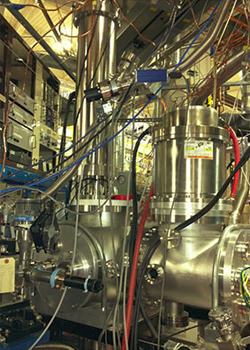
Polycyclic Aromatic Hydrocarbons (PAHs) are complex organic molecules that may incorporate up to one-third of the organic carbon in our galaxy and are involved in fundamental molecular mass growth processes in our galaxy. PAHs are found in carbonaceous chondrites (a class of meteorite) and may initiate an abiotic synthesis (making compounds using non-living molecules) of material vital to the earliest forms of life on present-day Earth.
The aromatic benzene molecule, discovered 175 years ago, is the basic molecular building block of PAHs. A research team, led by University of Hawaiʻi at Mānoa Department of Chemistry Professor Ralf Kaiser, has exposed synthetic routes (non-natural formation by chemical compounds) to form the aromatic benzene molecule in combustion flames and in hydrocarbon-rich atmospheres of planets and their moons. The team's findings were presented in the May 2021 issue of Science Advances.
Research method
Using high-tech instruments at the Advanced Light Source facility at the Lawrence Berkeley National Laboratory, a high-temperature chemical microreactor and advanced detection methods, the researchers combined the findings with calculations and simulations to discover the synthetic methods of forming the aromatic benzene molecule and its isomers through the ratio of two highly unstable organic radicals.
"This work provides compelling evidence on the formation of the very first ringed aromatic building block of PAHs—benzene—together with three structural isomers via previously poorly characterized radical—radical reactions," Kaiser said. "These results uncover fundamental mechanisms involved in molecular mass growth processes not only in hydrocarbon-rich solar systems environments, but also in combustion systems, thus gaining us a better understanding and rigid scientific foundation of the hydrocarbon chemistry of our universe."
The research team included Musahid Ahmed of Lawrence Berkeley National Laboratory and Alexander M. Mebel of Florida International University. This work was conducted in collaboration with Russian scientists from the Samara National Research University and the Lebedev Physical Institute. Funding for the study was provided by the Basic Energy Sciences program in the U.S. Department of Energy.
This work is an example of UH Mānoa's goal of Excellence in Research: Advancing the Research and Creative Work Enterprise (PDF), one of four goals identified in the 2015–25 Strategic Plan (PDF), updated in December 2020.







